The Queen Mary University of London 2021 International Arbitration Survey: Adapting Arbitration to a Changing World
In May 2021, QMUL published the results of its most recent survey examining user trends in international arbitration (available here). The survey is the result of over 1,200 completed questionnaires and nearly 200 interviews conducted during 2020.
Unsurprisingly, the focus of the survey is on how arbitration practice is keeping pace with, and adapting to, rapidly altering global circumstances, and whether the impacts of the pandemic have accelerated or derailed changes which were already underway. In this article, we look at the key findings in relation to the choice of arbitration, procedural improvements, the use of technology, and information security.
As ever, arbitration practitioners will also look to the survey for its findings on the use of arbitration and favoured seats and arbitral institutions. As to which:
- London and Singapore jointly were identified as the most preferred seats for international arbitration; and
- ICC and SIAC were identified as the top 2 most preferred arbitral institutions.
A summary of the further key findings and indicators of future trends are set out below.
Arbitration remains the preferred forum to resolve cross-border disputes
90% of survey respondents indicated that their preferred forum for resolving cross-border disputes is international arbitration, or international arbitration in conjunction with ADR (mediation or industry-specific approaches such as dispute boards and adjudication). Interestingly, 59% favoured arbitration in conjunction with ADR.
What is the most preferred seat for international arbitration?
As to the location or ‘seat’ of arbitration, the two most preferred seats were London and Singapore, each of which was favoured by 54% of respondents. Close behind was Hong Kong, followed by Paris, Geneva, New York, Beijing, Shanghai, Stockholm and Dubai, as shown on the graphic below.
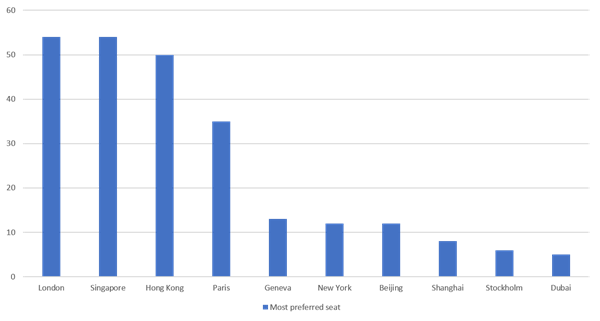
The fact that London remained top of the list (where it also appeared in QMUL’s 2018 survey) is indicative of its enduring global appeal notwithstanding Brexit.
What adaptations would make other seats more attractive to users?
With the increasing use of, and focus on, regional arbitration seats, and the ambitions of various jurisdictions to follow Singapore to become an arbitration ‘hub’, QMUL also asked survey respondents what adaptations would make seats more attractive to users of arbitration.
The responses point overwhelmingly to the importance of the local courts and judiciary in recognising and supporting the use of international arbitration. Evidently, permitting third party funding is no substitute for a supportive judiciary and impartial court system.
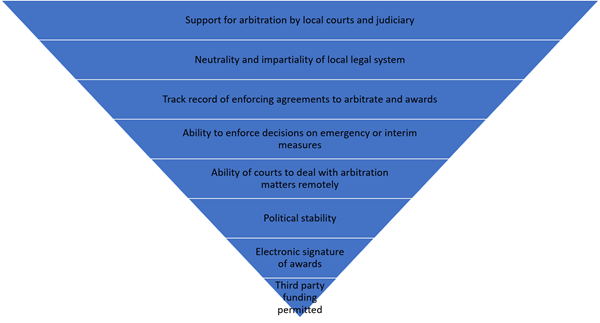
What are the most preferred arbitral institutions?
The most preferred arbitral institutions cited by survey respondents were ICC, SIAC, HKIAC and LCIA. This top 4 remains unchanged since 2018, but numbers of respondents selecting SIAC and HKIAC have both overtaken those selecting the LCIA, perhaps mirroring the recent success of Singapore as a seat.
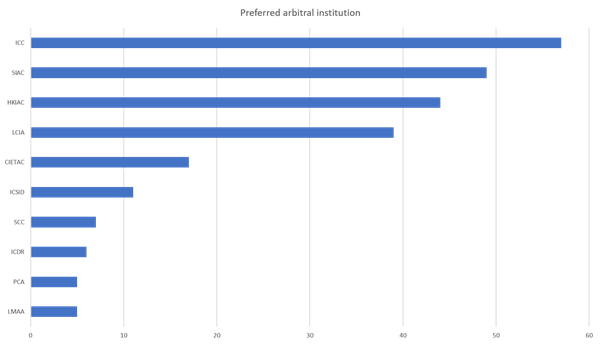
This change may also be a reflection of the increasing participation of survey respondents from Asia Pacific who in 2021 constituted 43% of survey respondents (up from 25% in 2018) overtaking the second largest constituency from Europe 24% (down from 35% in 2018).
Indeed, the relative regional participation in the survey may also be reflected in other findings, including in particular the relative low number of survey respondents citing US arbitral institutions or seats.
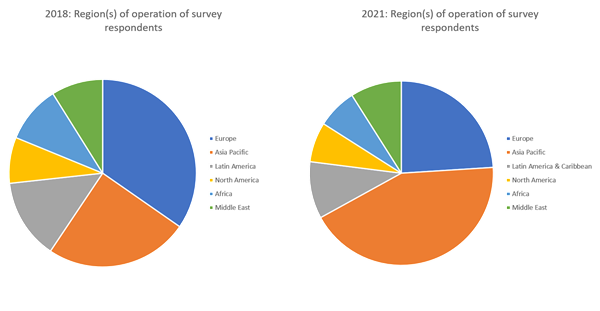
The survey includes breakdowns of the preferences for arbitral seat and institution by geographic region, which, unsurprisingly, show a degree of regional preference in both selections. In any event, the universal UNCITRAL Arbitration Rules remain the ad hoc regime of choice.
The survey also asked what adaptation would make an arbitration institution or its rules more attractive. Unsurprisingly, with many users arranging hearings remotely throughout 2020, administrative or logistical support for virtual hearings was the top requested adaptation, followed by a commitment to a more diverse pool of arbitrators, and transparency in the administrative procedures of the institution.
Diversity of arbitral tribunals
The diversity of tribunals deciding cases in international arbitration remains a topic of importance and discussion, in particular in terms of gender and ethnic or regional background.
61% of respondents to the survey felt that some progress had been made in relation to gender diversity in tribunals. However, there was a strong contrast with the other diversity markers discussed in the survey – namely geographic diversity, age, cultural and ethnic diversity – where less than one third of respondents felt that positive progress had been made. This is an almost identical result to the 2018 survey, which may suggest that initiatives started in the meantime have yet to be seen to bear fruit; although QMUL notes that certain of these statistics are inherently hard to measure, monitor, or even define.
The survey responses did not show any strong correlation between the perception of a tribunal as impartial and the perceived diversity of its membership. From its further interview discussions, QMUL concludes that the subject is a nuanced one, depending on what is meant by “diversity” in each case. The survey results also note that many respondents questioned the need for any such correlation to exist - there being no need in their view to find a justification for the need for a more diverse pool of arbitrators.
Use of technology
The challenges posed by the pandemic have led to significant adaptations across all dispute resolution forums, including international arbitration. It therefore comes as no surprise that the QMUL survey found that there has been a dramatic increase in the use of virtual hearing rooms, with 72% of users indicating that they have “sometimes”, “frequently”, or “always” employed them. This is a stark contrast to the 2018 results, when 62% of respondents reported that they had “never” used virtual hearing rooms.
Perhaps more interesting is how survey respondents stated they would in future expect to react to discovering that a scheduled hearing could no longer be held in person. 79% said that in those circumstances they would rather proceed at the scheduled time using a virtual hearing, with only a small number indicating that they would postpone for an in-person hearing or ask for the matter to be dealt with on paper (16% and 4% respectively). This suggests that the availability and newly-acquired familiarity with virtual hearing rooms may well shape parties’ approaches even after the worst of the pandemic has passed.
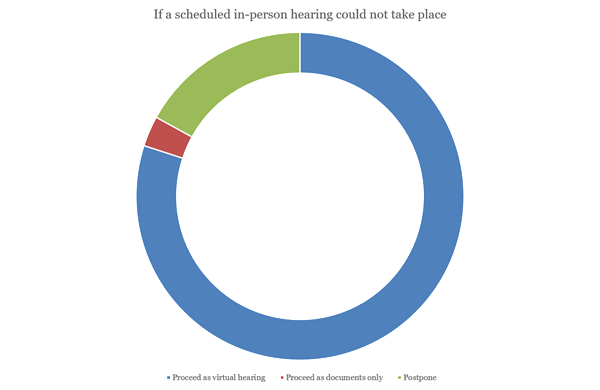
Advantages and disadvantages of virtual hearings
Asked for the main advantages of virtual hearings, respondents cited
- the potential for greater availability of dates,
- greater efficiency,
- greater procedural and logistical flexibility, and
- less environmental impact than an in-person hearing.
The main disadvantages on the other hand included
- difficulties caused by multiple time zones,
- the increased difficulty of parties and their counsel conferring during the hearing,
- difficulties assessing/controlling witnesses,
- technical malfunctions, and
- “screen fatigue”.
What is the future for virtual hearings?
Survey respondents were also asked how they would prefer in future to arrange aspects of international arbitration which traditionally take place face to face.
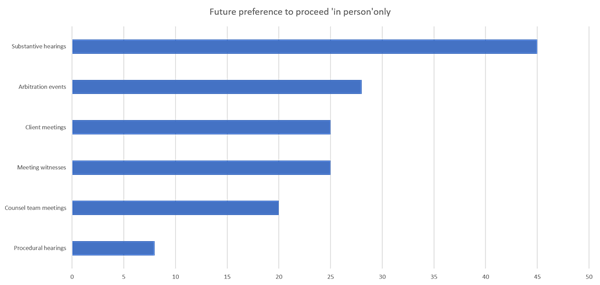
For the most part, the response was that a “mixed” format – that is, the flexibility to arrange such interactions in person or virtually, depending on the circumstances – would be preferred, with a narrow preference for procedural hearings to be held virtually. Significantly, fewer than half of all survey respondents expressed a firm preference for an in person substantive hearing (45%, whereas 48% favoured a mixed approach).
Sustainability
Survey respondents were asked which environmentally friendly measures they had used during arbitrations, and what measures they felt should be used. The most commonly adopted measures included producing documents, submissions, and hearing bundles in electronic form, rather than hard copy. Many respondents also indicated that they had used procedural conferences via telephone conference, video conference or virtual hearing room, although interview feedback indicated that this was not primarily driven by environmental concerns.
Data protection and cybersecurity in international arbitration
Finally, the QMUL survey addressed issues of data protection and cybersecurity. Whether data protection considerations impacted on the conduct of international arbitration was viewed as largely dependent on the participants and nature of the dispute. Low numbers of survey respondents felt that data protection issues have a significant impact at present. QMUL concludes that this may, in part, be due to a lack of familiarity with the potential impact of data protection regimes on international arbitration.
The majority of survey respondents (57%) indicated that they had seen cybersecurity measures put in place in less than half of their cases. In interviews, many indicated that the consideration depends on the nature of the dispute and identity of the parties (for example, disputes involving states might be approached differently). When measures are used, the most common cybersecurity techniques included the use of cloud-based platforms for sharing electronic data, limiting access to prescribed individuals, data encryption and access controls such as multi-factor authentication. The most popular measure that ‘should be used’ was the need for all arbitrators to adopt secure professional email addresses, rather than personal web-based email.
Conclusion
Once again, the QMUL survey has provided a wealth of information and reactions to inform the conduct and development of international arbitration. While the relative popularity of various seats and institutions will continue to attract attention, stakeholders will also want to take note of the continuing popularity of arbitration (and the desire to use it alongside ADR), and of the progress still to be made on important issues such as diversity and cyber-security.
For further Arbitration related content click here to access Disputes+, Bird & Bird’s disputes know how portal.



